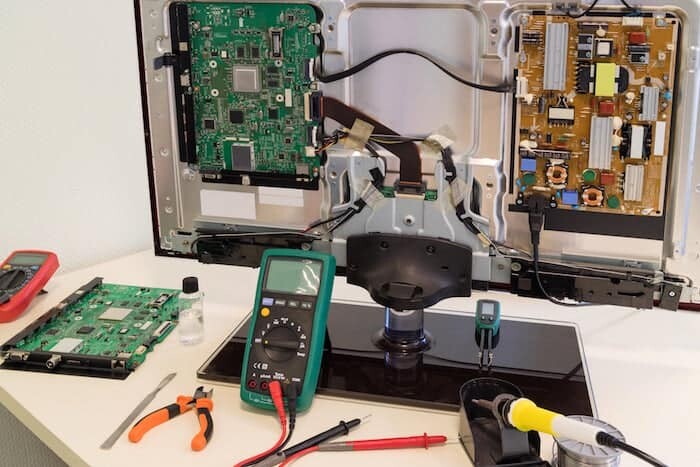Aerospace PCB Assembly: From Designs to Selecting Suppliers
What is Aerospace PCB Assembly?

Aerospace PCB assembly makes and assembles the Printed Circuit Board for aerospace applications. It ensures the board functions well in harsh environmental conditions. The main goal of this process is to identify and fix flaws before reaching customers or users.
Aerospace PCB assembly produces quality parts. Therefore, it offers various benefits compared to traditional PCB assembly methods. It functions well from the very initial days, which helps to save labour costs. If the testing process is successful, manufacturers don’t have to spend extra time and money on parts or labor. This eliminates the need to replace the parts later in the assembly process. Aerospace PCB manufacturers spend enough time planning and designing before manufacturing the PCB. Thus, it provides customer satisfaction with quality products, establishing the manufacturer’s reputation.
Applications of Aerospace PCB Assembly
Aerospace PCB assembly is used in technology and equipment across the aerospace industry. They should function fully in extreme operating conditions. This includes highly radioactive conditions, outer space, and extreme temperatures. The PCB assembly must withstand high-speed movement, vibrations, and impact. It must also withstand the conditions during takeoff and landing.
Some of the applications of Aerospace PCB assembly include:
Temperature sensors
Communication systems
Radar Installations
Satellite Technologies
Battery Management Units (BMS)
Flight Instruments and Equipment, etc.
Benefits of Aerospace PCB Assembly
PCB assembly plays a significant role in aerospace applications. It provides reliability and precision. Some of the benefits of Aerospace PCB Assembly includes:
Precision Engineering
In the aerospace industry, accuracy and precision are crucial factors. The electronic components in aerospace must resist harsh environments. In the aircraft sector, intricate designs and careful soldering are vital for building printed circuit boards (PCBs). This is necessary to ensure that the circuitry operates under challenging circumstances. Aircraft require precision engineering to avoid fatal mistakes.
Withstand Harsh Conditions
PCB manufacturers use copper and aluminium for high-temperature laminate substrates. This helps the boards survive extreme temperatures. Similarly, to mitigate the radiation, specialised materials are used.
Redundancy and Reliability
Designers and developers create aerospace units with backup options. Even if any components fail, there are backups. PCB assembly is crucial for designing redundant systems. It makes sure they operate smoothly, even if a component fails. To cut the risk of failure, rigorous testing and quality control measures are implemented during the entire PCB assembly process.
Materials Required for Aerospace PCB Assembly
Aerospace PCB assembly stands at the forefront of technological advancements. It requires materials that can withstand the rigours of space and airborne conditions. The selection of materials is considered a crucial factor. These include thermal management, shock absorption, and overall durability. Components enduring harsh environments for extended periods must be reliable. A single component failure could lead to extensive and costly repairs.
Choosing substrates is a critical aspect of aerospace PCB assembly. Aluminium and copper are prominent options. The assembly process is important. Some materials use buried or blind vias to join inner and outer layers.
Aerospace PCBs need special surface finishes. This is because they face extreme conditions, such as vibration, moisture, and heat. Protective coatings are crucial in preventing oxidation and corrosion, safeguarding exposed copper areas. Additionally, thermal compounds are applied to insulate heat sinks effectively.
Rigid-flex PCBs have emerged as a preferred choice for aerospace assembly. Beyond offering excellent conductivity, they showcase resistance to external agents. The amalgamation of rigid and flexible PCBs ensures a secure connection between circuit parts. It guarantees polarity and contact stability, especially in challenging assembly scenarios.
When selecting materials for aerospace PCBs, consider their ability to withstand thermal and radiation environments. High-temperature PCBs are essential for handling extreme conditions. They need to withstand engine temperatures that can reach several thousand degrees Celsius.
Materials for aerospace PCBs must have a low coefficient of thermal expansion (CTE). This minimizes size changes in response to temperature fluctuations. Laminate materials are often chosen for their CTE properties. They are similar to ceramic-bodied microcircuits soldered to PCBs. These laminates often have a polyimide base reinforced with glass. This similarity reduces stress on PCBs. It’s a crucial factor in aerospace environments. Temperatures can fluctuate between -45 °C and +85°C.
Aerospace PCB assembly has diverse material choices. Each choice presents unique advantages and considerations. FR4, for instance, is budget-friendly and robust. However, it lacks waterproof and flame-retardant properties. Glass-reinforced epoxy (GRP) comes at a higher cost. Yet, it stands out for its exceptional durability and can withstand extreme temperatures. Its impressive electrical properties and strong resistance to corrosion and abrasion make it an ideal choice for challenging environments. It’s expected to have high temperatures.
If you want a well-rounded solution that balances durability and electrical integrity at a reasonable cost, consider either FR4 or GRP boards. They have integrated copper traces. These materials deliver excellent conductivity. They also protect against abrasion and resist extreme temperatures. Notably, they are user-friendly. They do not need specialized equipment like lasers or plasma cutters during handling. This makes them practical and efficient choices for aerospace PCB assembly. They ensure a seamless blend of performance and cost-effectiveness.
Design Factors of Aerospace PCB Assembly
In the aerospace PCB assembly environment, design factors are critical for optimal performance and reliability. Some of the critical design factors include:
Compliance with IPC Class 3 standards
These standards are designed for electronic devices to operate in harsh environments. It includes extreme temperatures and exposure to corrosive chemicals. Heat resistance materials like AP, Pyralux and FR408 are some of the common choices for metal components.
Frequency Compatibility
Aerospace PCB is a mix of both low and high-frequency components to prevent interference. Thus, designers should design PCBs to differentiate the frequencies. This way, high-frequency components won’t interfere with signals from low-frequency components. Besides, the clock signal-generating components require additional shielding with the enclosure aluminium materials.
Material Selection
The aerospace environment can experience harsh conditions, including high temperatures, moisture and vibration. Thus, the manufacturer must choose a substrate like copper laminates or aluminium for strength. They may also consider ENIG and immersion silver. Besides, selecting materials with a low coefficient of thermal expansion will minimize the change in size from temperature fluctuations.
Shock Absorption
Aerospace devices are prone to mechanical vibrations. Therefore, shock-absorbing materials, like conformal coatings, should be used to protect the components from vibrations.
Surface Finish
Aerospace PCBs experience vibrations, moisture, and extreme temperatures; thus, they require a protective surface finish. During PCB assembly, apply a coating to prevent oxidation and corrosion. Also, the use of thermal compounds helps to insulate the heat sinks.
Electromagnetic Shielding
PCB manufacturers should incorporate EMI shielding. This includes proper routing, grounded planes, and shielding enclosures.
Factors to Consider While Selecting Aerospace PCB Assembly Supplier
Selecting the proper aerospace PCB assembly is crucial. It affects the performance and reliability of aerospace applications. Thus, before selecting the proper aerospace PCB assembly, consider the following factors:
Aerospace PCB assembly should follow strict specifications. This ensures its safety, reliability, and durability. Choose suppliers that meet relevant standards, such as AS9100, ISO 9001, and IPC-A-610. Also, ensure the standard compliance with the company standards and regulations.
Experience and Expertise
The aerospace application requires highly skilled and experienced expertise. Choose a supplier with a proven track of significant knowledge in aerospace PCB assembly. Check out their past projects and successes, considering industry-specific challenges.
Quality Control and Testing
Quality control and testing determine the reliability and durability of PCB assembly in aerospace applications. Thus, before selecting the PCB manufacturers and suppliers, check their quality control process. Also, check their testing process to align with industry standards. Ask about all the necessary tests for aerospace use. This includes vibration, heat, and function.
Material Selection
Aerospace PCB demands specific materials for quality assurance. Thus, choose the manufacturer by verifying that the supplier uses materials that comply with aerospace requirements.
Besides, check for the following factors:
Check for the delivery time and ability of the manufacturer to meet the deadlines.
Ensure the supplier provides clear communications, responsiveness, and continuous support throughout the PCB assembly process.
Compare the quote with multiple suppliers. Consider all the required factors like testing, quality of materials, industry standards, and extra services.
Ensure the manufacture is easy for customising the products.
Why Wells?
Get precise and reliable aerospace PCB assembly with Wells. Take your projects to new heights with our top-notch expertise. Our certified quality and advanced technology will help. Choose Wells for excellence in every circuit. Reach out to Wells today for superior aerospace innovation!
Conclusion
Aerospace PCB assembly is critical. It supports and operates electronic equipment under challenging conditions. It ensures reliability through precision engineering. The use of specific materials is known for their resistance to severe temperatures. Material selection determines the reliability of a PCB. This includes standards like IPC Class 3 and other aerospace requirements.
Choosing the right manufacturer is crucial. It guarantees the PCB quality for aerospace applications. The PCB manufacturer must meet specific standards to ensure high quality.



